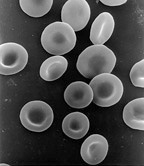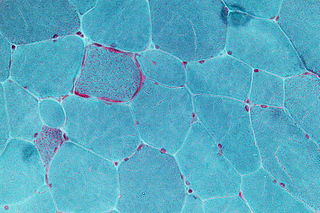
Anemia is a decrease in the total amount of red blood cells (RBCs) or hemoglobin in the blood, or a lowered ability of the blood to carry oxygen. When anemia comes on slowly, the symptoms are often vague and may include feeling tired, weakness, shortness of breath or a poor ability to exercise. Anemia that comes on quickly often has greater symptoms, which may include confusion, feeling like one is going to pass out, loss of consciousness, or increased thirst. Anemia must be significant before a person becomes noticeably pale. Additional symptoms may occur depending on the underlying cause.
Myalgia, or muscle pain, is a symptom of many diseases and disorders. The most common causes are the overuse or over-stretching of a muscle or group of muscles. Myalgia without a traumatic history is often due to viral infections. Longer-term myalgias may be indicative of a metabolic myopathy, some nutritional deficiencies or chronic fatigue syndrome.

Physiological plant disorders are caused by non-pathological conditions such as poor light, adverse weather, water-logging, phytotoxic compounds or a lack of nutrients, and affect the functioning of the plant system. Physiological disorders are distinguished from plant diseases caused by pathogens, such as a virus or fungus. While the symptoms of physiological disorders may appear disease-like, they can usually be prevented by altering environmental conditions. However, once a plant shows symptoms of a physiological disorder it is likely that, that season’s growth or yield will be reduced.

Manganese (Mn) deficiency is a plant disorder that is often confused with, and occurs with, iron deficiency. Most common in poorly drained soils, also where organic matter levels are high. Manganese may be unavailable to plants where pH is high.

The following outline is provided as an overview of and topical guide to organic gardening and farming:

Iron-deficiency anemia is anemia caused by a lack of iron. Anemia is defined as a decrease in the number of red blood cells or the amount of hemoglobin in the blood. When onset is slow, symptoms are often vague such as feeling tired, weak, short of breath, or having decreased ability to exercise. Anemia that comes on quickly often has more severe symptoms, including: confusion, feeling like one is going to pass out or increased thirst. Anemia is typically significant before a person becomes noticeably pale. Children with iron deficiency anemia may have problems with growth and development. There may be additional symptoms depending on the underlying cause.

Red blood cell distribution width is a measure of the range of variation of red blood cell (RBC) volume that is reported as part of a standard complete blood count. Usually red blood cells are a standard size of about 6-8 μm in diameter. Certain disorders, however, cause a significant variation in cell size. Higher RDW values indicate greater variation in size. Normal reference range of RDW-CV in human red blood cells is 11.5-14.5%. If anemia is observed, RDW test results are often used together with mean corpuscular volume (MCV) results to determine the possible causes of the anemia. It is mainly used to differentiate an anemia of mixed causes from an anemia of a single cause.
Micronutrients are essential elements required by organisms in small quantities throughout life to orchestrate a range of physiological functions to maintain health. Micronutrient requirements differ between organisms; for example, humans and other animals require numerous vitamins and dietary minerals, whereas plants require specific minerals. For human nutrition, micronutrient requirements are in amounts generally less than 100 milligrams per day, whereas macronutrients are required in gram quantities daily.

A metabolic disorder can happen when abnormal chemical reactions in the body alter the normal metabolic process. It can also be defined as inherited single gene anomaly, most of which are autosomal recessive.

Human iron metabolism is the set of chemical reactions that maintain human homeostasis of iron at the systemic and cellular level. Iron is both necessary to the body and potentially toxic. Controlling iron levels in the body is a critically important part of many aspects of human health and disease. Hematologists have been especially interested in systemic iron metabolism because iron is essential for red blood cells, where most of the human body's iron is contained. Understanding iron metabolism is also important for understanding diseases of iron overload, such as hereditary hemochromatosis, and iron deficiency, such as iron deficiency anemia.
ICD-10 is an international statistical classification used in health care and related industries.
Cat skin disorders are among the most common health problems in cats.
Skin disorders in cats have many causes, and many of the common skin disorders that afflict people have a counterpart in cats. The condition of a cat's skin and coat can also be an important indicator of its general health. Skin disorders of cats vary from acute, self-limiting problems to chronic or long-lasting problems requiring life-time treatment. Cat skin disorders may be grouped into categories according to the causes.
Iron metabolism disorders may involve a number of genes including HFE and TFR2.

Micronutrient deficiency or dietary deficiency is not enough of one or more of the micronutrients required for optimal plant or animal health. In humans and other animals they include both vitamin deficiencies and mineral deficiencies, whereas in plants the term refers to deficiencies of essential trace minerals.
Mineral deficiency is a lack of the dietary minerals, the micronutrients that are needed for an organism's proper health. The cause may be a poor diet, impaired uptake of the minerals that are consumed or a dysfunction in the organism's use of the mineral after it is absorbed. These deficiencies can result in many disorders including anemia and goitre. Examples of mineral deficiency include, zinc deficiency, iron deficiency, and magnesium deficiency.
Nutritional anemia refers to types of anemia that can be directly attributed to nutritional disorders.Examples include Iron deficiency anemia and pernicious anemia.It is often discussed in a pediatric context.

Zinc deficiency occurs when plant growth is limited because the plant cannot take up sufficient quantities of this essential micronutrient from its growing medium. It is one of the most widespread micronutrient deficiencies in crops and pastures worldwide and causes large losses in crop production and crop quality.










